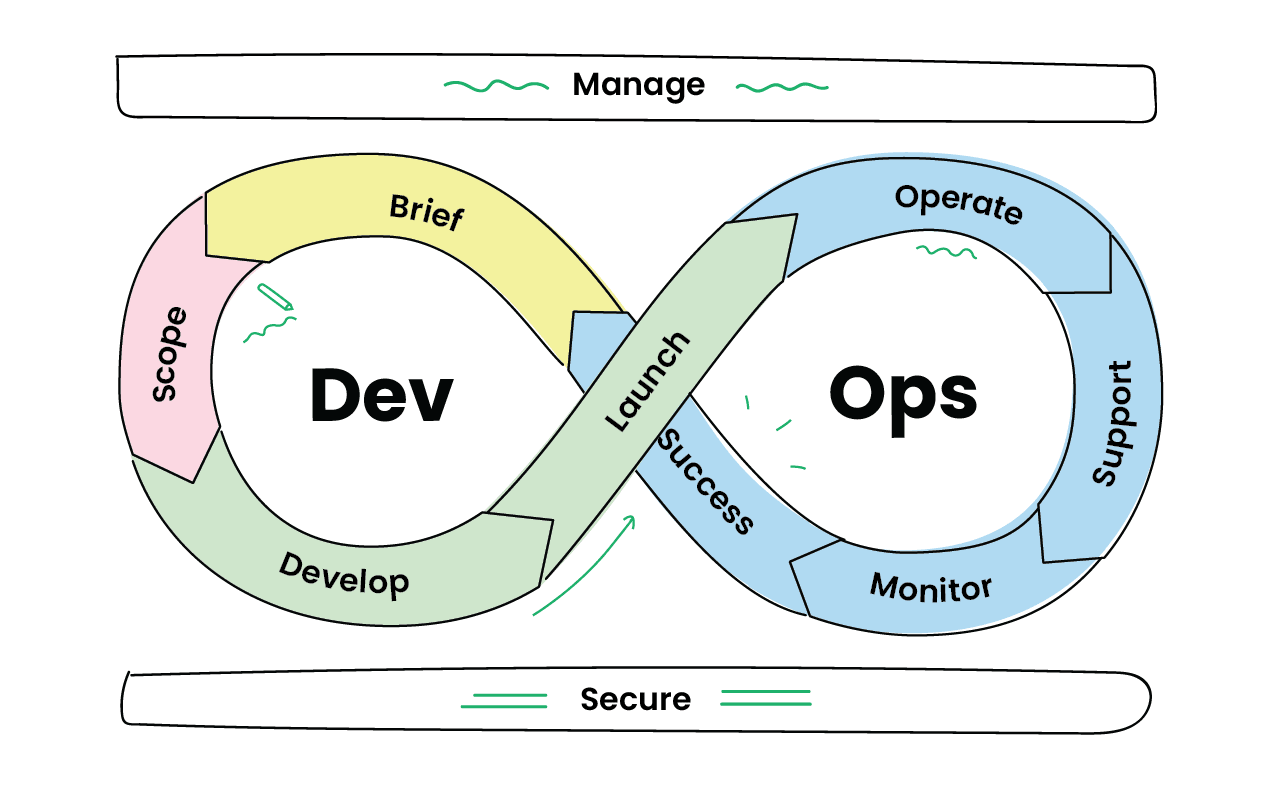4 Advantages of DevOps and CI/CD Pipelines
DevOps is a pretty broad term with plenty of technical jargon associated. For the non-technical, understanding what DevOps is and how it impacts their project can be a bit overwhelming. That’s why we felt it was important to break down the basic definitions and terminology associated with DevOps and explore the advantages that can be felt from investing in practices like a CI/CD pipeline.
What is DevOps?
First things first, the name DevOps is a mashup of Development and Operations. It primarily relates to the stage between those two areas.
Every definition of DevOps differs slightly, so here’s our variation. DevOps is the use of tools, processes and people to improve an organisation's ability to deliver digital products and services at a high velocity.
Yes, that is a very broad definition - this is 100% deliberate.
There is so much innovation and improvement in software development that it’s easier to group some of these under a common banner.
One of the most common examples used when referring to DevOps is Continuous Integration/Continuous Deployment pipelines (CI/CD).

DevOps Cycle within a Software Development Agency
One of the most frequent terms within DevOps is CI/CD. In 2024, CI/CD remains critical for streamlining software development and deployment:
• Continuous Integration (CI): This involves merging code changes into a central repository where a pipeline validates those changes through tests and builds.
• Continuous Delivery/Continuous Deployment (CD): Continuous Delivery means the code changes pass through a series of automated tests and checks, making it ready for release into a live environment. Continuous Deployment takes this further by automatically deploying every code change that passes all checks, eliminating the need for manual approvals.
CI/CD has transformed software release processes, moving away from traditional “release days” towards frequent, smaller releases. This transformation has allowed teams to prioritise testing and quality assurance.
4 Advantages of DevOps and Release Pipelines in 2024
1. Automation Reduces Risk:
Automated release pipelines significantly minimise risk by removing the manual steps prone to human error. In 2024, tools like GitLab, Jenkins, and GitHub Actions have made automated pipelines even more accessible. As more organisations adopt Infrastructure as Code (IaC) practices (using tools like Terraform or Pulumi), the manual processes involved in software deployment have been further reduced.
2. Improves Efficiency and Reduces Costs:
In modern DevOps practices, a manual release might take several hours, while an automated release pipeline can do it in minutes. This efficiency translates to significant cost savings. With fortnightly releases becoming the norm for many agile teams, these time and cost savings accumulate rapidly.
3. Emphasises Quality Assurance:
Testing and quality assurance controls are now built into release processes. By integrating modern testing tools like Cypress, Playwright, and containerised testing environments, automated and consistent feedback on software quality is provided instantly. Cross-platform and cross-device testing are now more streamlined, ensuring features can be quickly verified in various environments.
4. Empowers Your Team to Do More:
In 2024, the demand for DevOps specialists remains high. However, modern, comprehensive pipelines have empowered application developers to handle more aspects of the release process independently. Advanced tools such as Kubernetes, Docker, and advanced monitoring solutions like Prometheus and Grafana allow for efficient management and greater visibility over deployments.

How WorkingMouse Leveraged DevOps in 2024
WorkingMouse, like many forward-thinking agencies, has taken several steps to enhance its DevOps capabilities:
1. Upgrade to the Latest DevOps Tools:
Continuous improvements are vital. WorkingMouse updated its GitLab environment to the latest version (v17 in 2024) to leverage enhanced automation features. This upgrade unlocked improved pipeline visualisation, integrated AI-driven testing, and automatic dependency scanning to identify vulnerabilities.
2. Building Out CI/CD Pipelines:
With newer features available in tools like GitLab, WorkingMouse built out advanced CI/CD pipelines that automate testing, building, and reviewing apps. These pipelines provide detailed reports, ensuring a smooth and automated workflow for every code merge.
3. Enhanced Visibility Through Integrations:
WorkingMouse integrated its GitLab with various communication tools (e.g., Slack, Microsoft Teams) to provide automated updates on the progress of code merges and deployments. Such integrations enable developers and project teams to keep track of releases without manual follow-up.
4. Deprecating Existing Automation Tools:
Outdated automation tools like Jenkins have been replaced with modern solutions. While some projects transitioned to newer platforms immediately, others followed a phased approach to minimise disruptions. This is part of an industry-wide trend towards adopting integrated tools that simplify DevOps practices, such as GitLab CI, GitHub Actions, and Azure DevOps Pipelines.
WorkingMouse is continuously experimenting with new tools and practices to deliver even better results for its clients in the near future.




.png)











